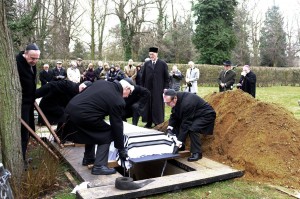By Lior Alperovich
The city of Norwich, East Anglia, has the dubious honor of being the site of the first ritual murder accusation in Europe to be directed against Jews.
It began in 1144, with the discovery of the body of a boy named William in a forest near the town. Since the murder occurred close to Easter, William’s family assumed that the boy had been crucified by his Jewish employers as a ritual act of vengeance against Christianity.
Although the story spread rapidly across Europe, it was investigated only some five years later, when a Benedictine monk named Thomas of Monmouth arrived in Norwich to obtain proof of William’s martyrdom. Thomas published his conclusions in The Life and Miracles of St. William of Norwich, including two testimonies whose anti-Semitic motifs would become an integral part of later blood libels.
In the first testimony, the Jewish suspects’ Christian maidservant claimed to have peeked through the kitchen door and seen them pouring boiling water on the unfortunate William. Historian Yisrael Yaakov Yuval has suggested that the water was being used to kasher kitchenware by immersion in boiling water for Passover; primed by New Testament tales of the Jews’ role in the death of Jesus, however, the maid’s imagination gave the scene its sinister twist.
The second, even more fascinating testimony was that of a certain Theobald, supposedly a local Jew until the horrifying murder and subsequent miracles persuaded him to embrace Christianity. Ancient Jewish sources, he alleged, required Christian bloodshed in order to hasten the Jews’ redemption and return to Zion. Exiled and enslaved as punishment for the death of Jesus, the Jews sacrificed a Christian boy each year in revenge. Jewish leaders gathered annually in Narbonne, Provence, to draw lots. One of the Jewish communities in the country thus chosen would be selected, also by lottery, to carry out the ritual murder. That year, he stated, the “honor” fell to the Jews of Norwich.
Skeletons from the Past
It was long thought that the Norwich libel never went beyond malevolent rumor; no historical evidence of any sentencing or punishment had come to light. Norwich apparently tolerated its Jewish inhabitants at least until 1190, when almost the entire community was massacred.
Then in 2004, a discovery made while digging foundations for a shopping center in downtown Norwich turned this assumption upside down. Seventeen skeletons were found at the bottom of a deep shaft, apparently a well. Their positions reflected neither Christian or Jewish burial customs, but it was seven years before forensic experts were brought in as part of the popular BBC series History Cold Case. Prof. Sue Black of the University of Dundee’s Centre for Anatomy and Human Identification and Dr. Ian Barnes, an expert in DNA identification, dated the skeletons to the 12th or 13th century. Eleven belonged to children under age fifteen, five of them siblings. All the skeletons came from the same ethnic group – one totally dissimilar to that of the local population. Jews?
Laboratory testing ruled out plague as the cause of death. Further tests showed that the adults’ bones, unlike the young people’s, had sustained impact fractures. Black and Barnes concluded that the adults had been thrown down the well head-first; the children had been tossed in after them, therefore sustaining less severe injuries.
These seventeen Jews may have been victims of the massacre that obliterated their community in the winter of 1190 – the same year as the massacre of the Jews of York and riots in Lincoln. Or they might have perished in an earlier, unrecorded eruption of violence resulting from the blood libel forty-six years earlier.
Since the History Cold Case investigation in 2011, the bones have remained in the custody of the Norwich Castle Museum, despite efforts to give them a dignified burial. Curator Alan West told the Jewish Chronicle that “there is nothing to suggest they are of Jewish origins.”
But last month, as a result of lobbying by Norwich community representative Clive Roffe and members of the local clergy, the Jewish Board of Deputies persuaded the museum to allow the bones’ burial. Despite inconclusive DNA testing, the rabbis involved found sufficient grounds for interment in a Jewish cemetery.
On March 19, in a ceremony attended by some fifty Jews and Christians, all seventeen bodies were buried in the Earlham Orthodox Cemetery in Norwich. Local rabbi Alex Bennet read an introductory prayer and Bishop David Gillet, an interfaith adviser in the Diocese of Norwich, eulogized the deceased. A monument stating that the bodies were probably the victims of an anti-Jewish pogrom – such as the one against Norwich’s Jews in 1190 – will mark the grave.
For more articles from this author and other stories about Jewish History please visit Segula Magazine.
The words of this author reflect his/her own opinions and do not necessarily represent the official position of the Orthodox Union.


